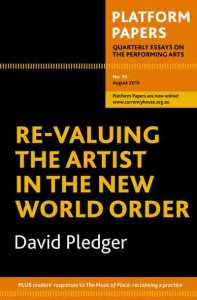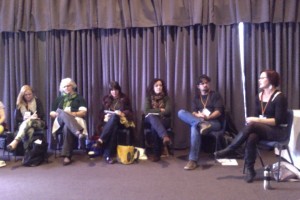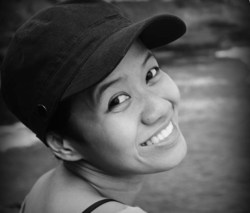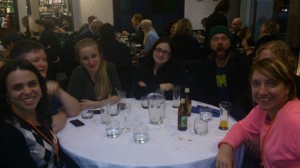Australian Theatre Forum 2013 | Wednesday (After Lunch)
- June 2nd, 2013
- Posted in Uncategorized
- Write comment

After a big morning of ideas: plenty plenty plenty to think and talk about, I could really only be super superficial in my conversation at Lunch time : “How about this weather?” “Isn’t Canberra well organized?” “What am I eating?” etc etc
Next up were working sessions and presentations which happening concurrently around the Canberra Theatre Centre and this felt a little more than frustrating – because I could have happily sat in on all working groups to listen and learn and Tweet about and share with friends and followers who may be in other sessions/other cities other countries… but that is the thing with theatre, theatre forums and live events: you will always miss out on something, somewhere, sometime.
The great thing is that theatre folk have a way of communicating their ideas about the shows I inevitably miss, that makes me still interested and somehow still manage to be inspired post-event by what they are talking about. (This is particularly true when I hear the stories of Rex Cramphorn’s works from James Waites)
WORKING SESSIONS AND PRESENTATIONS – THE ARTIST IS DEAD. LONG LIVE THE ARTIST

For almost ten years Platform Papers has insinuated itself into the national conversation by enabling artists to make significant contributions to cultural discourse. Currency Press Board Director Martin Portus and upcoming contributor artist David Pledger discuss the value of ideas in public discourse specifically in relation to the arts and artists.
Speakers: Martin Portus in conversation with David Pledger
(I REALLY REALLY wanted to attend this session, but was called to another corner of the Forum. Lucky for me Jane Howard attended this session. Read her post HERE )
WORKING SESSIONS AND PRESENTATIONS – COLLABORATIONS AND COLLECTIVE ADVOCACY FOR YOUTH THEATRE COMPANIES

A conversation touching on working collaboratively, collectively preparing for the future, and longer term advocacy with artists and managers working within the youth theatre sector.
Host: Amanda Foote;
Facilitators: Imogene Shields, Fraser Corfield, Caitlin Newton-Broad
In a small room in the Canberra Theatre Centre, Imogene Shields (Currently the Creative Director, Youth Arts Queensland and previously the General Manager for Young People and the Arts Australia – which you can read about HERE) asked us to quickly identify who we were and what we are excited about.
For me, this is one of the most important discussions that could happen as a part of any Theatre forum – it deals directly with future sustainability of art, artists, community and audience. Unfortunately often relegated to a small or back room, Youth arts in Australia seems to do much of the “heavy lifting” as far as the health of the future community and industry (I know I used that word and by community I mean the wider context in which art companies operate).
(A few contextual things about me in relation to youth arts. My post-university practice started at PACT in Erskineville as a part of the imPACT ensemble under Caitlin Newton-Broad (CNB was in her mid 20s when she took over the Artistic Directorship of PACT- a notion which is nearly hard to fathom now that a person so young could be a leader of a significant youth arts company) Eleven years later as a board member at Shopfront I advocated VERY hard to recruit her and Howard Mathew to be joint ADs/CEOs of Shopfront – and passionately argued “for” a co-artistic directorship (which goes to show our beginnings never know our ends…) Early in my career I moved to Canada to work on a largescale Community Theatre Project which resulted in me starting up a child-lead youth theatre company wherein I developed and lead collective playwriting practices for children aged 6-15 years. And since that time (and my return to Australia) I have been obsessed with the importance of Youth Arts. I continue to sit on the board of Shopfront and have a great passion for youth and emerging arts as a place of great/vital innovation for the arts… my sentiments are best articulated by Lenine Bourke and Mary Ann Hunter in Not Just an Audience: Young People Transforming Theatre http://www.currencyhouse.org.au/node/143 )
The Youth Arts space is a complex one: wherein companies are often asked to works, whilst skilling-up participants on a part time schedule with little resources and limited time. Of course the KPIs set by funding bodies (like many companies) relate to numbers of participants NOT depth of experience for the participants nor the far-reaching social, personal or industrial impacts of the programs or projects. The continuing issues are around resourcing a sector means that partnerships are essential – but also complex.
The discussion was largely around expectation setting for partnership with corporates about the creative ownership of the work also a discussion around the artistic or aesthetic merit of the work versus the community or educational impact of the work… these are both slippery measures of success: not easily evaluated.
So how can we measure the success of youth arts practice when the impact may only be felt in 20-30 years time?
Tricky.
And one of the big questions asked was since the adverse funding decision by the Australia Council impacted the National peak body for Youth Arts in Australia – what does the sector need to stablize, to advocate, to share learnings and models and strategies?
The break out into smaller working groups I sat with Fraser Corfield leading a discussion on advocacy for the Youth Sector: a desire to formulate a cross-sectoral block of statistics about reach, diversity and impact.
A mindfulness about celebrating the creativity of children/youth/young emerging artists is essential – providing participants with a sense of power over their own creative destiny and not seeing art making as something that can be “taught” but something that can be self-discovered, self generating, self-lead. In my view it’s important to always ensure that the artist (regardless of age) is confident and robust and curious and enthusiastic about their creativity.
And the most difficult thing to come to terms with for an artist is the fluxing , changing nature of their practice and their field.
KEYNOTE: RIA PAPERMOON – A STORY OF PAPERMOON IN JOGJAKARTA’S CONTEMPORARY ART SCENE
Papermoon Puppetry Theatre uses puppetry to create multimedia and site-specific works that explore intimate moments of Indonesia’s past and present. Founder and Artistic Director, Ria Papermoon, introduces delegates to Jogjakarta’s diverse and dynamic arts scene.

“Maria Tri Sulistyani or Ria, as she is known, is the founder and co-artistic director of Papermoon Puppet Theatre. Graduating in Communication Studies from the Social Politics Faculty of Gadjah Mada University, Ria chose to found Papermoon as the answer of her passion of performing arts, visual arts and art education. “Puppetry is an awesome medium for me to communicate with people. It’s unpredictable, full with surprise, and actually could trap the audience to the situation that they never imagine.” Being the Asian Cultural Council Grantee 2009-2010 and stay in New York City for 6 months, staying in the middle of farm land for a month in South Korea, making art installation in ex-red light district in Yokohama-Japan for 2 months, performing in New Delhi-India, doing collaborating works with students in Singapore for several times, doing workshops at Papua, Sumatera and several towns in Java, and just got back for 1 month tour in United States in 5 states and 7 cities, made her love to Yogyakarta -the city where she lives now- blossoms bigger and bigger. And she will tell you why, at ATF 2013.”
A fantastic post from Jane about this HERE
The most powerful learning that comes from Ria – and Jane Howard articulates it beautifully in her post – is the need to always be responsive to the audience, to context to the setting in which art exists.
An earthquake – stops visitation? Change how you engage with audiences.
You are curious about puppets? Educate yourself.
Asked to make a work for a New York audiences? Research that audience and adapt work.
This type of responsive approach is interesting and the fact I find it interesting speaks to the “set and forget” branding many companies have: and of course its not surprising where the art-creation model is government funded and a “proven track record” is a priority in each grant application. This risk-adverse framework (yes governments by nature are risk adverse) means that art and artists can be locked in to an idea of how or what is possible. Ria started her company “on the pocket money of my husband…” and now is an international artist.
And with artists KNOWN for innovation and surviving in lean financial times: when I heard Ria’s story I had to ask myself, amongst so many discussions around funding and money, “What in the arts is really holding any of us back?” (That is, if we feel held-back, which some might not.)
Ria’s presentation also revealed how democratising the internet is as a tool: “I wanted to know, so I ask the great Google: Make puppets for adults? And Zooom! There it is: how to make puppets for adults.” And so I have to ask, in the case of the democratisation of information and education,”What in the arts is really holding any of us back?”
And again, Ria spokes of creating works as installations in other people’s houses “You need a place so we make a place – an installation in someone’s house – you have to have friends with a big heart for that.” And so I have to ask, in the case of the feeling that there are limited venues or limitations around art spaces, “What in the arts is really holding any of us back?”
Ria spoke of creating work which triggered protests, to which she shrugged and didn’t seem to be bothered by. And so I have to ask, in the case of a friendly and non-hostile audience, “What in the arts is really holding any of us back?”
And so through someone’s success comes the bravery to say that I feel pretty inspired to open possibility up for myself and my own practice.
CASH BAR
Joined by TippingPoint Australia Delegates at 6pm
And at the end of a long LONG day, of much talking and hundreds of Tweets – I was really just looking forward to some face to face time – talking and eating and getting to know some people in a different setting… Not a bar, but dinner…
And a natural group of gypsies found each other: and there was noodles and coconut ice-cream and talk and confession and laughter…

*****END OF DAY ONE*****